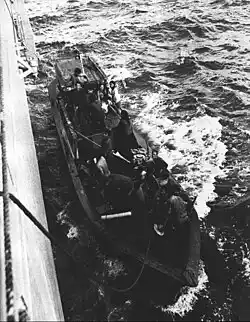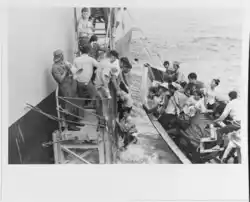
The Vietnamese boat people are refugees who fled from Vietnam in the immediate aftermath of the end of the Vietnam War in 1975 and the fall of Saigon, the capital of South Vietnam, and in the years that followed. Many of the Vietnamese who fled in 1975 and 1976 were people who had collaborated with the United States during the war in one way or another and feared political persecution once Vietnam was reunited under communist rule. Others who left in the longer term were leaving for economic reasons.
The number of Vietnamese boat people who left their country between 1975 and 1995 was between 800,000 and one million. They primarily left for nearby countries like Thailand, Indonesia, Malaysia, the Philippines and Australia, often on small or makeshift boats. The Vietnamese boat people have helped to make the Vietnamese diaspora one of the largest of any Asian nation worldwide.[1]
Research your ancestors on MyHeritage
Vietnamese boat people chronology of eventsVietnamese boat people chronology of events
The Vietnamese boat people were a by-product of Vietnam’s torturous history in the decades following the end of the Second World War. The country was colonized along with Cambodia and Laos by the French in the second half of the nineteenth century. Indochina was occupied by the Japanese during the Second World War, during which time a communist partisan resistance movement emerged. It morphed into an independence movement after the war and fought the First Indochina War against the French between 1946 and 1954. This culminated in the division of the country into a communist Democratic Republic of Vietnam in the north, or North Vietnam as it became known, and a western-aligned State of Vietnam in the south, or South Vietnam, ruled by a succession of military hardmen, under the terms of the Geneva Accords.[2]

The Second Indochina War commenced almost immediately in 1955 and saw North and South Vietnam at war with one another. In order to prevent the fall of South Vietnam to the North and the extension of communist rule in Indochina, the United States began offering a growing level of support through the late 1950s and into the 1960s. By the mid-1960s the Second Indochina War had effectively become a Vietnam War between the North Vietnamese and the United States. As is well known, the US lost the conflict, despite pouring millions of men and all its military might into the effort. Peace terms allowed for a gradual US withdrawal from South Vietnam in the mid-1970s.[3] As the last US troops pulled out, the North Vietnamese occupied large parts of South Vietnam and captured the southern capital, the city of Saigon in April 1975, uniting the country under communist rule after three decades of bitter fighting against the French, South Vietnamese and Americans.[4]
Hundreds of thousands of people had actively collaborated with the South Vietnamese government and the Americans in one form or another during the long Vietnam War and many feared persecution under the new regime. While some were repatriated to the United States, most had to fend for themselves after being abandoned by their erstwhile ally. Thus, as South Vietnam was taken over in 1975 and in the months that followed, hundreds of thousands of people began fleeing the country. Because Cambodia was experiencing the horrors of the Khmer Rouge regime and the genocide it perpetrated in the second half of the 1970s and Laos was itself only beginning to emerge from a protracted civil war, these countries were not optimum for fleeing over the land border. Thus, these Vietnamese political exiles took to the sea, often on small boats or vessels that were little more than makeshift rafts. The Vietnamese boat people, as they would become known, consisted of hundreds of thousands of people between 1975 and 1979, though migration continued into the 1980s and beyond.[5]
Extent of migration of the Vietnamese boat peopleExtent of migration of the Vietnamese boat people
There was an initial mass flight from South Vietnam in the mid-1970s as those who had actively played a role in or collaborated with the South Vietnamese government and the United States feared that if they remained in their country they would be persecuted by the communist regime. Thus, hundreds of thousands of people fled the country between 1974 and 1976. This process continued on a more restricted basis for years to come as more people became disgruntled with the regime. Approximately a half a million people had fled Vietnam on small boats by the end of 1978.[6]
Many of The Vietnamese boat people that fled during these years were Hoa people of Chinese ancestry in Vietnam. These were encouraged to leave the country as relations deteriorated with China after the war with the US ended, culminating in the short-lived Sino-Vietnamese War in the spring of 1979. People continued to leave Vietnam, often on boats and albeit in smaller numbers, well into the 1980s and even into the early 1990s. In total somewhere between 800,000 and two million Vietnamese people fled as boat people from their country in the two decades following US defeat in the Vietnam War and the unification of the country under communist rule, though over time it became more difficult to distinguish between political refugees and economic migrants.[7]
Demographic impact of the Vietnamese boat peopleDemographic impact of the Vietnamese boat people

The demographic impact of the migration of the boat people was felt primarily in other countries around the South China Sea and the Gulf of Thailand. The majority settled in Malaysia, Singapore, Thailand and Hong Kong, the latter of which was still under British rule at the time. Others arrived to the Philippines and Indonesia, though these countries were less receptive to their arrival and many boat people ended up in refugee camps for years. Others even headed by sea as far as Japan and Australia, though clearly in smaller numbers.[8]
These boat people added strongly to the Vietnamese diaspora. There are half a million Vietnamese people in Japan today, over 330,000 in Australia, upwards of half a million in Taiwan, 80,000 in Malaysia and tens of thousands in Singapore. The number of people of Vietnamese origin in Thailand is uncertain, with various estimates placing it between 100,000 and half a million. In Hong Kong, the Vietnamese refugee population grew to nearly 200,000 in the 1980s, but owing to varying policies of resettlement and a distinction being made between political refugees and economic migrants, that figure has declined over time. Not all of these diaspora communities are entirely the result of the migration of the Vietnamese boat people, but this wave of migration following the end of the Vietnam War has certainly been a major contributory factor. Many people of Vietnamese heritage in the Western Pacific will have a near ancestor who left Vietnam as one of the boat people in the period from the mid-1970s onwards.[9]
See alsoSee also
Explore more about the Vietnamese boat peopleExplore more about the Vietnamese boat people
- How the End of the Vietnam War Led to a Refugee Crisis at History
- Vietnamese refugees boat arrival at National Museum of Australia
- When the Boat People Came to Hong Kong at SixthTone
References
- ↑ https://www.history.com/news/vietnam-war-refugees
- ↑ https://www.history.com/this-day-in-history/geneva-conference-begins
- ↑ https://www.history.com/topics/vietnam-war/vietnam-war-history
- ↑ https://diplomacy.state.gov/stories/fall-of-saigon-1975-american-diplomats-refugees/
- ↑ Justus M. van der Kroef, ‘The Vietnamese Refugee Problem’, in World Affairs, Vol. 142, No. 1 (Summer, 1979), pp. 3–16.
- ↑ https://media.nationalgeographic.org/assets/file/vietnamese_MIG.pdf
- ↑ Gareth Porter, ‘Vietnam’s Ethnic Chinese and the Sino-Vietnamese conflict’, in Critical Asian Studies: Bulletin of Concerned Asian Scholars, Vol. 12, No. 4 (1980), pp. 55–60.
- ↑ https://media.nationalgeographic.org/assets/file/vietnamese_MIG.pdf
- ↑ https://www.sixthtone.com/news/1010214

